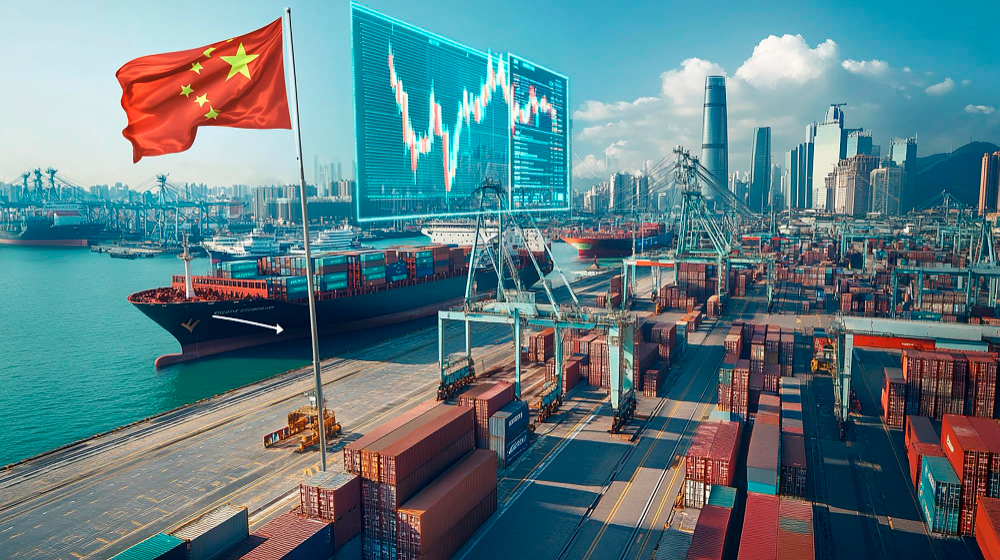China’s Trade Surplus and Deficit Analysis by Year
Category: Chinese chance Date: 2024-09-29 Views: 2
China has been a major player in the global economy for decades, and its trade surplus and deficit have been closely watched by economists and policymakers around the world. A trade surplus occurs when a country exports more goods and services than it imports, while a trade deficit occurs when a country imports more than it exports. In recent years, China has consistently maintained a trade surplus, meaning that it exports more than it imports.
This has led to concerns about the impact of China's trade surplus on the global economy, as well as the implications for specific industries and government policies. China's trade surplus has been a topic of much debate and analysis in recent years. The country's rapid economic growth and industrialization have led to a significant increase in its exports, particularly in the manufacturing sector.
This has resulted in a trade surplus that has been the subject of much scrutiny and concern. On the other hand, China's trade deficit in specific industries, such as high-tech products and advanced machinery, has also raised questions about the country's long-term economic sustainability. As a result, there has been a growing focus on understanding the factors contributing to China's trade surplus and deficit, as well as the potential impact on the global economy.
Factors Contributing to China's Trade Surplus
There are several key factors that have contributed to China's trade surplus in recent years. One of the main factors is the country's strong manufacturing sector, which has allowed it to produce a wide range of goods at competitive prices. This has made Chinese products highly sought after in international markets, leading to a significant increase in exports.
Additionally, China's large population and growing middle class have created a strong domestic market for goods and services, further boosting the country's export potential. Another factor contributing to China's trade surplus is the country's currency policy. The Chinese government has been accused of artificially devaluing its currency in order to make its exports more competitive in international markets.
This has led to criticism from other countries, particularly the United States, which has accused China of engaging in unfair trade practices. In response, China has made efforts to gradually liberalize its currency policy in recent years, but concerns about currency manipulation continue to be a source of tension in international trade relations.

Impact of China's Trade Surplus on Global Economy
China's trade surplus has had a significant impact on the global economy in recent years. On one hand, it has contributed to the country's rapid economic growth and industrialization, making China a major player in international trade. This has led to increased investment and job creation in China, as well as greater access to affordable goods for consumers around the world.
However, China's trade surplus has also raised concerns about its impact on other countries, particularly those with large trade deficits. One of the main concerns about China's trade surplus is its impact on other countries' manufacturing sectors. The influx of cheap Chinese goods has put pressure on domestic industries in many countries, leading to job losses and decreased competitiveness.
This has led to calls for greater protectionism and trade barriers in some countries, as well as efforts to address unfair trade practices by China. Additionally, China's large foreign exchange reserves, which are largely a result of its trade surplus, have raised concerns about the country's influence on global financial markets and its ability to manipulate exchange rates.
Analysis of China's Trade Deficit in Specific Industries
While China has maintained a trade surplus overall, it has also experienced a trade deficit in specific industries. One of the main areas where China has a trade deficit is in high-tech products and advanced machinery. This is largely due to the country's reliance on imported technology and components for its manufacturing sector, as well as its efforts to transition to a more innovation-driven economy.
Additionally, China's growing middle class has led to increased demand for high-quality consumer goods, many of which are imported from other countries. The trade deficit in specific industries has raised concerns about China's long-term economic sustainability and its ability to compete in high-value-added sectors. In response, the Chinese government has made efforts to promote innovation and technology development, as well as to increase investment in research and development.
Additionally, China has sought to address its trade deficit through initiatives such as the "Made in China 2025" plan, which aims to upgrade the country's manufacturing capabilities and reduce its reliance on imported technology.
Government Policies and Initiatives to Address Trade Imbalance
The Chinese government has implemented a number of policies and initiatives in recent years to address its trade imbalance and promote more balanced economic growth. One of the main initiatives is the "Belt and Road" initiative, which aims to promote infrastructure development and connectivity between China and other countries. This initiative is seen as a way to increase China's export potential and reduce its reliance on traditional markets.
Additionally, the Chinese government has made efforts to promote domestic consumption and reduce its reliance on exports as a driver of economic growth. This includes measures such as increasing wages and social welfare benefits, as well as promoting greater investment in services and consumer goods. The government has also sought to address concerns about currency manipulation by gradually liberalizing its currency policy and promoting greater exchange rate flexibility.
Comparison of China's Trade Surplus and Deficit Over the Years
China's trade surplus and deficit have fluctuated over the years, reflecting changes in global economic conditions and domestic policies. In recent years, China has maintained a consistent trade surplus, driven by its strong manufacturing sector and export potential. However, the country has also experienced a growing trade deficit in specific industries, particularly high-tech products and advanced machinery.
The Chinese government has made efforts to address these imbalances through various policies and initiatives, with mixed results. While China has made progress in reducing its reliance on traditional export markets and promoting domestic consumption, concerns about unfair trade practices and currency manipulation continue to be sources of tension in international trade relations. Additionally, China's growing influence on global financial markets and its large foreign exchange reserves have raised concerns about its impact on the global economy.
Future Outlook for China's Trade Balance
Looking ahead, there are several key factors that will likely shape the future outlook for China's trade balance. One of the main factors is the ongoing transition to a more innovation-driven economy, which will likely impact China's trade deficit in specific industries. The Chinese government's efforts to promote innovation and technology development are expected to reduce the country's reliance on imported technology and components, potentially leading to a more balanced trade position.
Additionally, China's growing middle class and increasing domestic consumption are expected to play a key role in shaping the country's future trade balance. As Chinese consumers demand higher-quality goods and services, there will likely be increased opportunities for domestic producers and reduced reliance on exports as a driver of economic growth. However, concerns about unfair trade practices and currency manipulation are likely to remain sources of tension in international trade relations, particularly with the United States.
In conclusion, China's trade surplus and deficit have been closely watched by economists and policymakers around the world due to their significant impact on the global economy. While China has maintained a consistent trade surplus overall, it has also experienced a growing deficit in specific industries. The Chinese government has implemented various policies and initiatives to address these imbalances, with mixed results.
Looking ahead, the ongoing transition to a more innovation-driven economy and increasing domestic consumption are expected to shape the future outlook for China's trade balance. However, concerns about unfair trade practices and currency manipulation are likely to remain sources of tension in international trade relations.

